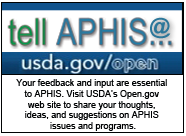![]()
Contact:
R. Andre Bell (301) 851-4059
Lyndsay Cole (970) 494-7410
USDA Expands Field Trials of New Oral Rabies Vaccine for Use in Raccoons and Other Wildlife in 5 States
 |
WASHINGTON, Aug. 13, 2012 - The U.S. Department of Agriculture's Animal and Plant Health Inspection Service’s (APHIS) Wildlife Services (WS) program will conduct a second U.S. field trial of a vaccine to control rabies in raccoons, skunks, and other wildlife beginning this month. The expansion was approved after an environmental assessment process.
The field trial will distribute more than one million oral rabies vaccination (ORV) baits in Vermont, New Hampshire, New York, Ohio, and West Virginia to test the safety and efficacy of the ONRAB® vaccine for potential use in wildlife. The ONRAB® vaccine is currently used in Canada to control rabies in raccoons, skunks and foxes. The vaccine was field tested in the United States for the first time in West Virginia last year. Results from the 2011 U.S. field trial with ONRAB® were promising and warranted additional, expanded testing of the vaccine for potential licensure by the USDA APHIS Center for Veterinary Biologics (CVB).
WS works cooperatively with local, state and federal governments, universities and other partners to reduce the prevalence of rabies in wildlife by distributing ORV bait in targeted areas. While the bait currently used in ORV programs has proven to be effective in raccoons, coyotes, and foxes, it does not produce detectable levels of immunity in striped skunks.
“Skunks infected with the raccoon rabies virus are helping to perpetuate and maintain the virus in the environment,” notes Richard Chipman, Coordinator for the WS National Rabies Management Program. “If the ONRAB® bait can successfully vaccinate skunks as well as increase the vaccination rate in raccoons, foxes, and coyotes, it could greatly improve the overall effectiveness of our rabies control programs.”
Previous use of ONRAB® in Canada has resulted in a vaccination rate for skunks of 17-51 percent and a vaccination rate for raccoons of greater than 70 percent. Results from the 2011 field trial in West Virginia showed development of antibodies in blood of raccoon at rates approaching 50 percent; an inadequate sample of skunks was captured to evaluate a response to ONRAB®. The current ORV bait vaccination rates in the United States are approximately 0 and 30 percent for skunks and raccoons, respectively.
WS personnel will sample skunks and raccoons in the study areas both prior to and immediately following bait distribution to determine vaccination rates. The field trials are a collaborative effort among APHIS-WS, APHIS-CVB, the Centers for Disease Control and Prevention, the vaccine manufacturer (Artemis Technologies, Guelph, Ontario, Canada), and state departments of Agriculture, Health and Human Resources, and National Resources.
- In the northeastern U.S., the 2012 field trial will take place within a study area approximately 3,536 mi2 in size and spanning portions of Clinton and Essex counties, NY; Addison, Essex, Franklin, Grand Isle, Orleans, Lamoille, Caledonia, Chittenden, and Washington counties, VT; and Coos and Grafton counties, New Hampshire.
- In Ohio, the study will cover 939 mi2 including 433 mi2 covered by ground and helicopter baiting. ONRAB baits will be distributed in portions of Cuyahoga, Geauga, Lake, Portage and Summit counties.
- The ONRAB® vaccine field trial will be duplicated and expanded in southeastern West Virginia, encompassing 904 mi2 in portions of Fayette, Greenbrier, Mercer, Monroe, Pocahontas, Raleigh, and Summers counties.
The ONRAB® bait consists of a polyvinyl chloride (PVC) blister pack, containing the vaccine. To make the baits attractive, the blister packs containing the vaccine are coated with a sweet attractant that includes vegetable-based fats, wax, icing sugar, vegetable oil, artificial marshmallow flavor, and dark-green food-grade dye. [Link to photo.] Humans and pets cannot get rabies from contact with the bait, but are asked to leave the bait undisturbed if they encounter it. If contact with bait occurs, the contact area should be immediately rinsed with warm water and soap.
The cooperative WS National Rabies Management Program was established in 1995 to prevent the further spread of wildlife rabies in the United States by containing and eventually eliminating the virus in terrestrial mammals and focuses efforts on controlling raccoon variant, canine variant in coyotes, and a unique variant of gray fox rabies.
Rabies is a serious public health concern because if left untreated it is always fatal. Costs associated with detection, prevention and control of rabies exceeds $300 million annually. According to the Centers for Disease Control and Prevention, about 90 percent of reported rabies cases in the United States are in wildlife.
For additional information concerning rabies or the ORV program, please visit www.aphis.usda.gov/wildlife_damage/oral_rabies/index.shtml or contact WS toll free at 1-866-4-USDA-WS (1-866-487-3297).
With Agriculture Secretary Vilsack’s leadership, APHIS works tirelessly to create and sustain opportunities for America’s farmers, ranchers and producers. Each day, APHIS promotes U.S. agricultural health, regulates genetically engineered organisms, administers the Animal Welfare Act, and carries out wildlife damage management activities, all to safeguard the nation’s $157 billion agriculture, fishing and forestry industries. In the event that a pest or disease of concern is detected, APHIS implements emergency protocols and partners with affected states and other countries to quickly manage or eradicate the outbreak. To promote the health of U.S. agriculture in the international trade arena, APHIS develops and advances science-based standards with trading partners to ensure America’s agricultural exports, valued at more than $137 billion annually, are protected from unjustified restrictions.
#
Note to Reporters: USDA news releases, program announcements and media advisories are available on the Internet and through Really Simple Syndication (RSS) feeds. Go to the APHIS news release page at www.aphis.usda.gov/newsroom and click on the RSS feed link.
USDA is an equal opportunity provider, employer and lender. To file a complaint of discrimination, write:
USDA, Director, Office of Civil Rights, 1400 Independence Ave., SW., Washington, DC 20250-9410 or call
(800) 795-3272 (voice) or (202) 72-6382 (TDD).
